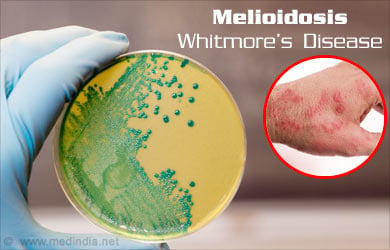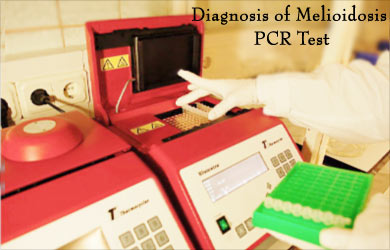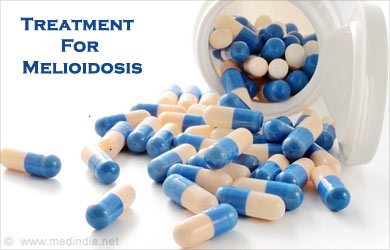- Melioidosis - (http://www.cdc.gov/melioidosis/index.html)
- Melioidosis: Epidemiology, Pathophysiology, and Management - (http://www.ncbi.nlm.nih.gov/pmc/articles/pmc1082802/)
- Melioidosis in northern Australia, 2001-02 - (http://www.health.gov.au/internet/main/publishing.nsf/content/cda-pubs-cdi-2003-cdi2702-htm-cdi2702n.htm)
- CBRNE - Glanders and Melioidosis - (http://emedicine.medscape.com/article/830235-overview)
What is Melioidosis?
Melioidosis is an infectious disease caused by a bacterium, Burkholderia pseudomallei. Melioidosis causes a wide range of manifestations in the body.
Infectious diseases are diseases that are caused by organisms. Many organisms are known to cause disease, including bacteria, viruses, fungi or parasites. Infectious diseases can spread from person to person and by several other means. To ascertain whether a disease is infectious or not, certain criteria called Koch’s postulates have to be met. Signs and symptoms of infectious diseases vary depending on the type of organism and the general condition of the patient, but fever and malaise are salient features of almost all infectious diseases. Infectious diseases in children usually differ in that the organisms causing the diseases are different and the immune capacity of children may not be strong enough to handle diseases that adults can usually handle. Based on the organism causing the disease, infectious diseases can be classified as:

- Bacterial
- Viral
- Fungal
- Parasitic
- Prion disease
Melioidosis is an infectious disease. It is caused by direct contact with water and soil contaminated with Burkholderia pseudomallei. It is prevalent in Northern Australia and South East Asia, but outbreaks have also occurred in far off places like Brazil. Many cases of melioidosis have also been diagnosed in India.
The disease caused by this bacterium encompasses a wide range of manifestations in the body, which range from no symptoms or signs at all, to a fatal dissemination of the bacterium in the blood. Several factors modulate the type of disease one might get.
Causes and Risk Factors of Melioidosis
Melioidosis is caused by a bacterium called Burkholderia pseudomallei, which is found in soil and water. It can be transmitted by contact with contaminated soil and water.
The causative organism of melioidosis is a bacterium called Burkholderia pseudomallei. It was first described in 1911 in Burma by Alfred Whitmore and C.S.Krishnaswami.
Transmission of the bacterium can happen by several means:
- Inhalation of contaminated material
- Contact with contaminated material like soil through a break in the skin
- Drinking contaminated water

There are certain risk factors for the development of severe disease. These include the presence of conditions like:
- Diabetes mellitus
- Renal impairment
- Immunocompromised condition
- High alcohol consumption
- Thalassemia
- Chronic Lung Disease
Symptoms and Signs of Melioidosis
Melioidosis usually presents with fever, body pain, breathing difficulty, and may sometimes cause rapid deterioration in health and also death.

The signs and symptoms of melioidosis depend on the type of infection caused, but none are pathognomonic.
Localized infection
This is usually caused due to infection through a break in the skin (inoculation). It presents as:
- Skin ulcer
- Skin nodule
- Skin abscess
Patients typically have fever, pain and swelling near the site of inoculation
Pulmonary infection
Worldwide, this type of melioidosis is the most common. Again, the severity of disease can vary from mild symptoms of bronchitis to severe lung infection. Symptoms include:
- Cough with or without sputum production
- Breathing difficulty
- High fever
Bloodstream infection
Patients who are immunocompromised, or who are already sick and have other risk factors, are likely to develop bloodstream infection and septic shock. The symptoms and signs include:
- High fever
- Altered mental status
- Respiratory distress
- Drop in blood pressure
- Joint pain
- Abscesses may be found throughout the body
Very severe disease may also result in death. Mortality due to melioidosis is high even in developed countries.
Disseminated infection
Disseminated infection presents with abscesses in various parts of the body, which may or may not be associated with sepsis. The organs commonly affected are:
- Liver
- Spleen
- Lung
- Prostate
- Joints and bones
- Lymph Nodes
- Brain
- Skin
Signs and symptoms of disseminated infection depend on the organ involved. Patients with liver abscesses may have upper abdominal pain and jaundice. Spleen involvement may present as prolonged fever with undetermined cause and vague symptoms. Brain involvement is rare, and melioidosis may cause meningitis and its associated signs and symptoms.
Diagnosis of Melioidosis
The diagnosis of melioidosis is based on culture and immunological tests. Imaging tests may also be needed.
The diagnosis of melioidosis in regions where it is not prevalent is difficult because it can mimic various diseases and because it is difficult to isolate.
- The best test to prove infection is blood culture and culture from the abscesses
- Other blood tests including cell counts, inflammation markers such as ESR, CRP and other routine tests are also done
- Immunologic tests are available, including:
- ELISA
- Complement Fixation
- PCR
- Chest x-rays are taken to look for lung infection
- CT scan of the abdomen, chest or the brain may be necessary depending on the type of infection and the organ affected
- In some cases, MRI scan of the affected region may be done
- Cotrimoxazole
- Ceftazidime
- Meropenem
- Filgrastim (G-CSF) in case of septic shock
- Cotrimoxazole
- Doxycycline
- Amoxycillin
- Chloramphenicol

Treatment for Melioidosis
The treatment of melioidosis is based on the use of specific antibiotics in two phases.
Treatment of melioidosis is standardized according to guidelines and involves specific antibiotics, used in two phases of treatment. On occasions, specialists may use other antibiotics based on culture results and their clinical judgment.

The standard treatment for melioidosis includes
Intensive phase, in which regimens containing some of the following drugs may be used:
The intensive phase is carried on for 14 days or more depending on the infection
Eradication phase, which may include some of the following drugs:
The eradication phase is carried on for 3-6 months.







